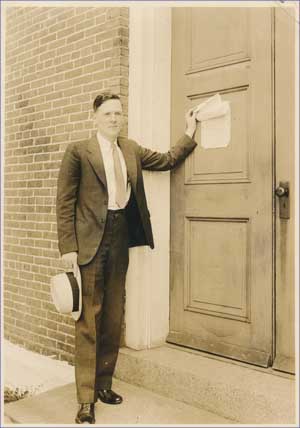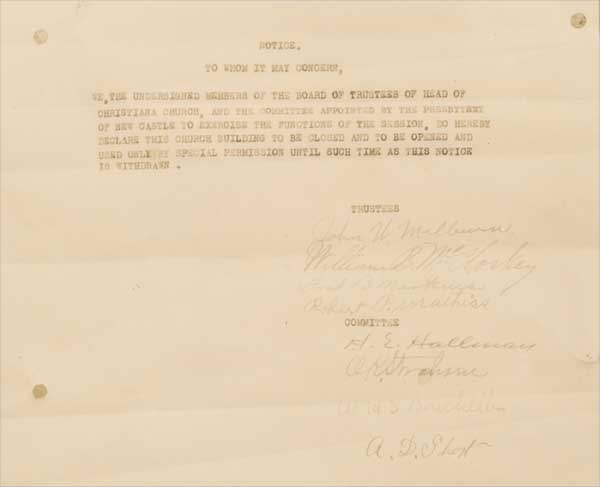STUDIES IN THE WESTMINSTER SHORTER CATECHISM
by Rev. Leonard Van Horn
Q. 21. — Who is the Redeemer of God’s elect?
A. — The only Redeemer of God’s elect is the Lord Jesus Christ, who, being the eternal Son of God, became man, and so was, and continueth to be, God and man, in two distinct natures, and one person forever.
Scripture References: I Tim. 2:5; John 1:1,14; John 10:30; Phil. 2:6; Gal. 4:4; Phil. 2:5-11.
Questions:
1. Why is the Redeemer of God’s elect called the Lord Jesus Christ?
He is called the Lord because of His sovereignty and dominion (Acts 10:36). He is called Jesus because He is the Saviour of His people (Matt. 1:21). He is called Christ because He is anointed by the Father with the Holy Ghost which was given to Him without measure (Acts 10:38). He is fully qualified by God.
2. How does the Lord Jesus Christ redeem the elect of God?
He purchases them by His blood and rescues them by His conquest by spoiling principalities and powers. (I Peter 1:18,19. Col. 2:15)
3. What did the Lord Jesus Christ become in order to redeem God’s elect?
He became man but did not cease to be God. He became Immanuel, God with us.
4. Why was it necessary that He become man?
It was necessary in order that He might be capable of suffering death for man and that He might become their High Priest that could reconcile them to God (Heb. 8:16,17).
5. How could Christ be both God and man?
Christ is God and man by a personal union. Both His natures are distinct, the divine nature is not subject to change and the human o nature is not omnipotent.
6. Could some compact statements be given regarding the constitution of the Redeemer’s person?
J. B. Green has probably put it in the most concise way:
“1. The reality of the two natures.
2. The integrity of the new natures.
3. The distinctness of the two natures after the union.
4. The oneness of the personality.”
BE VERY SURE
The fact that Jesus Christ is the only Redeemer of God’s elect is one for which we should ever thank God. Though it is difficult for us to understand the intricacies of how He could be both God and man; of how the two natures are distinct and yet He is one; we can certainly thank and praise God He that did purchase us by His own blood and thus become the only Redeemer of God’s elect.
The fact is a wondrous fact and yet the question must be asked and answered by all: Are we certain that we are among those He purchased and saved? The hymn writer puts it very well when he says, “Be very sure, Be very sure, Your anchor holds and grips the Solid Rock! This Rock is Jesus, Yes, He’s the One, This Rock is Jesus, The only One.” (Mrs. Ruth Caye Jones). For indeed, as the title of the hymn so aptly puts it, “In Times Like These” we need a Saviour.
To be able to discuss, and have an understanding of, theology is a good and healthy thing. The church needs this discipline, the church needs to have a better understanding of what the Standards teach. It is a sad fact that many Presbyterians could not even name what makes up the Standards. We repeat, it is good to have theological knowledge. But as we approach in this Catechism Question another theological fact, that of the Redeemer of God’s elect, it is even more important to have a personal knowledge of the Redeemer Himself, Jesus Christ.
As you read this short article, two questions are in order. First, Do you know Christ as your Saviour and Lord? Joseph Alleine puts it very plain when he says, “Though of yourselves you can do nothing, yet you may do all through His Spirit enabling you, and He offers assistance to you. God bids you ‘wash and make you clean.’ God invites you to be made clean and entreats you to yield to Him. O accept His offers, and let Him do for you, and in you, what you cannot do for yourselves.” (Prov. 1:24, Rev. 3:20). Second, If you believe Christ has saved you, are you acting as if He has saved you? Has your life changed, are old things passing away, are all things becoming new?
To have the theological knowledge that He is the Redeemer of God’s elect is good. Do you have the Heart knowledge? Isa.47:4.

 In these United States, we are accustomed to seeing various historical figures from the early days of our country on our paper currency. From 1997 to 2009, the people of Scotland were used to seeing the picture of a Presbyterian missionary by the name of Mary Slessor on their ten pound bank-note. On one side of the bill, Mary Slessor was seen holding a child and literally surrounded by other children from that nation of Nigeria. On the other side of the legal tender, there was a map of her mission station in what is now eastern Nigeria. It is still legal tender in Scotland, even though her picture on the ten pound note has been replaced by someone else.
In these United States, we are accustomed to seeing various historical figures from the early days of our country on our paper currency. From 1997 to 2009, the people of Scotland were used to seeing the picture of a Presbyterian missionary by the name of Mary Slessor on their ten pound bank-note. On one side of the bill, Mary Slessor was seen holding a child and literally surrounded by other children from that nation of Nigeria. On the other side of the legal tender, there was a map of her mission station in what is now eastern Nigeria. It is still legal tender in Scotland, even though her picture on the ten pound note has been replaced by someone else. The Rev. Henry G. Welbon, fundamentalist pastor recently unfrocked by the Presbytery of New Castle for his refusal to bow to that body in the fundamentalist-modernist conflict, found himself locked out of Head-of-Christiana church when he went there yesterday to conduct Sunday services.
The Rev. Henry G. Welbon, fundamentalist pastor recently unfrocked by the Presbytery of New Castle for his refusal to bow to that body in the fundamentalist-modernist conflict, found himself locked out of Head-of-Christiana church when he went there yesterday to conduct Sunday services.